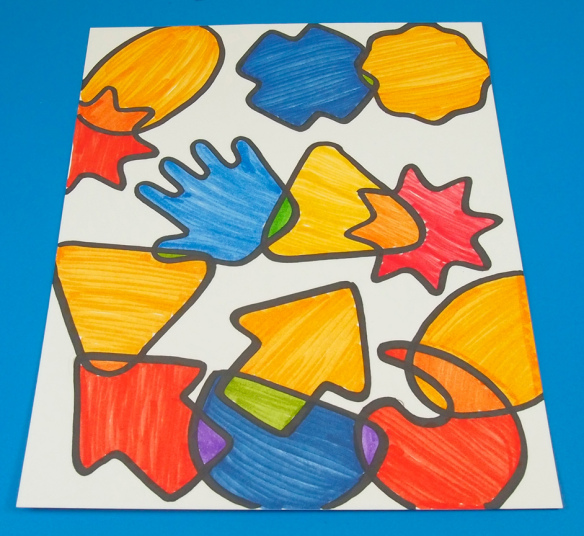
 Blend basic shapes and create a colorful collage art piece! Great for rainy day art projects.Young children will love tracing out the fun shapes. The stencils are easy to manipulate and perfectly-sized for small fingers to handle. Build fine motor skills while combining colors and shapes for interesting effects!
Blend basic shapes and create a colorful collage art piece! Great for rainy day art projects.Young children will love tracing out the fun shapes. The stencils are easy to manipulate and perfectly-sized for small fingers to handle. Build fine motor skills while combining colors and shapes for interesting effects!
Age: 3-5
Duration: 15-20 minutes
You’ll Need:
• R58620 Fine Motor Skills Silly Stencils
• Markers or crayons
• Paper
• Pencils
 Each of the stencils feature a shape that can be popped out, resulting in one stencil and one template. Two students can work at a time using the same shape. There are 27 stencils and 27 templates in total, which gives you the most value for your students’ art!
Each of the stencils feature a shape that can be popped out, resulting in one stencil and one template. Two students can work at a time using the same shape. There are 27 stencils and 27 templates in total, which gives you the most value for your students’ art!
 Set out all your materials. Each of the stencils are color-coded: The yellow stencils all contain basic shapes such as squares, triangles, trapezoids, hexagons, circles and so on. You can discuss the different shapes with your students and ask them to describe the other shapes they see in the pack.
Set out all your materials. Each of the stencils are color-coded: The yellow stencils all contain basic shapes such as squares, triangles, trapezoids, hexagons, circles and so on. You can discuss the different shapes with your students and ask them to describe the other shapes they see in the pack.
The red stencils feature slightly more difficult shapes. These shapes are recognizable shapes like hearts, swirls, stars, clovers and more!
The blue stencils are the most challenging shapes to trace out. Use these shapes for more complex drawings.
 Trace out one of the simpler shapes onto the paper sheet. Use pencil to make the tracing. If you make a mistake, you can always go back and erase it. Choose a completely different shape and place it partly over the first drawing. Trace the inside of the shape and remove the stencil. This will result in an overlapping stencil artwork!
Trace out one of the simpler shapes onto the paper sheet. Use pencil to make the tracing. If you make a mistake, you can always go back and erase it. Choose a completely different shape and place it partly over the first drawing. Trace the inside of the shape and remove the stencil. This will result in an overlapping stencil artwork!
 Adjust the directions of the shapes as you overlap them. Only overlap large areas of the stencils to help with the coloring later on. Fill the whole page with as many shapes as you can.
Adjust the directions of the shapes as you overlap them. Only overlap large areas of the stencils to help with the coloring later on. Fill the whole page with as many shapes as you can.
 Go back over top of the pencil lines with black marker. This will help you clearly see all the areas you have to color in.
Go back over top of the pencil lines with black marker. This will help you clearly see all the areas you have to color in.
 Clearly outline all of the shapes with black marker.
Clearly outline all of the shapes with black marker.
 Choose basic colors for each of the shapes. If you are teaching primary colors and color combinations to students, give them only red, blue and yellow markers to color in their art. Fill in the main part of the shapes with one color. Leave blank the parts that overlap.
Choose basic colors for each of the shapes. If you are teaching primary colors and color combinations to students, give them only red, blue and yellow markers to color in their art. Fill in the main part of the shapes with one color. Leave blank the parts that overlap.
 Now comes the fun part! Think about what color is created when red and yellow combine–it’s orange! What about yellow and blue? That’s easy–green! Fill in the overlapped areas of the shapes with these combination colors, also called secondary colors. Learn about tertiary colors as well!
Now comes the fun part! Think about what color is created when red and yellow combine–it’s orange! What about yellow and blue? That’s easy–green! Fill in the overlapped areas of the shapes with these combination colors, also called secondary colors. Learn about tertiary colors as well!
 All filled in! You can see the secondary colors that appear in the overlapped parts are either green, purple or orange.
All filled in! You can see the secondary colors that appear in the overlapped parts are either green, purple or orange.
Give students a range of materials to experiment with as they discover new colors! Use paints instead of markers. Paste on collage materials with similar colors onto specific sections; then mix up the contents in the overlapped areas and see what happens! Do you still see different colors?
What shape is your artwork in? Show us your color combinations and fun stencil artwork by sending us photos! Contact us through the contact form. We will post up your art in one of our upcoming posts!
